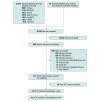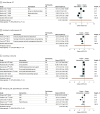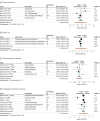Interventions Associated With Reduced Loneliness and Social Isolation in Older Adults: A Systematic Review and Meta-analysis
- PMID: 36251294
- PMCID: PMC9577679
- DOI: 10.1001/jamanetworkopen.2022.36676
Interventions Associated With Reduced Loneliness and Social Isolation in Older Adults: A Systematic Review and Meta-analysis
Abstract
Importance: Loneliness and social isolation are public health concerns faced by older adults due to physical, cognitive, and psychosocial changes that develop with aging. Loneliness and social isolation are associated with increased morbidity and mortality.
Objective: To evaluate interventions, targeting older adults, associated with a reduction in loneliness and social isolation.
Data sources: OVID, CINAHL, CENTRAL, Embase, PsychINFO, Web of Science, and Scopus were searched from inception to March 2020.
Study selection: Peer-reviewed randomized clinical trials measuring loneliness and social isolation or support in adults aged 65 years or older. Only English language articles were included.
Data extraction and synthesis: Two independent reviewers screened studies, extracted data, and assessed risk of bias. Random-effects models were performed to pool the overall effect size by intervention. Statistical heterogeneity was evaluated with the I2 statistic and by estimating prediction intervals. Data were analyzed from November 2021 to September 2022.
Main outcomes and measures: Quantitative measures of loneliness, social isolation, or social support based on an effect size of standardized mean differences.
Results: Seventy studies were included in the systematic review (8259 participants); 44 studies were included in the loneliness meta-analysis (33 in the community with 3535 participants; 11 in long-term care with 1057 participants), with participants' ages ranging from 55 to 100 years. Study sizes ranged from 8 to 741 participants. Interventions included animal therapy, psychotherapy or cognitive behavioral therapy, multicomponent, counseling, exercise, music therapy, occupational therapy, reminiscence therapy, social interventions, and technological interventions. Most interventions had a small effect size. Animal therapy in long-term care, when accounting for studies with no active controls, had the largest effect size on loneliness reduction (-1.86; 95% CI, -3.14 to -0.59; I2 = 86%) followed by technological interventions (videoconferencing) in long-term care (-1.40; 95% CI, -2.37 to -0.44; I2 = 70%).
Conclusions and relevance: In this study, animal therapy and technology in long-term care had large effect sizes, but also high heterogeneity, so the effect size's magnitude should be interpreted with caution. The small number of studies per intervention limits conclusions on sources of heterogeneity. Overall quality of evidence was very low. Future studies should consider measures of social isolation in long-term care and identify the contextual components that are associated with a reduction in loneliness.
Conflict of interest statement
Figures




References
-
- National Center for Health Statistics. Vital and health statistics. series 3, number 43. 2019. Accessed June 21, 2022. https://www.cdc.gov/nchs/products/index.htm
-
- National Prevention Council . Healthy aging in action: advancing the national prevention strategy. 2016. Accessed June 23, 2022. https://www.cdc.gov/aging/pdf/healthy-aging-in-action508.pdf - PubMed
-
- Social Care Institute for Excellence . At a glance 60: preventing loneliness and social isolation among older people. 2012. Accessed March 2, 2022. https://www.scie.org.uk/publications/ataglance/ataglance60.asp
-
- Bernard S, Perry H. Loneliness and social isolation among older people in north yorkshire: executive summary. York. 2013. Accessed March 2, 2022. https://eprints.whiterose.ac.uk/77336/1/Lone.pdf

